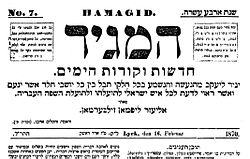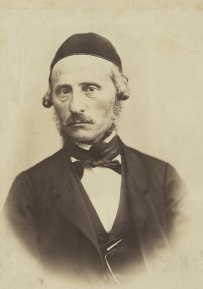 | |
| Type | Weekly newspaper |
|---|---|
| Founded | 1856 |
| Political alignment | Zionism |
| Language | Hebrew |
| Ceased publication | 1903 |
| Headquarters | Lyck, East Prussia |
| Country | East Prussia |
| Free online archives | Online, searchable Hamagid editions from the Historical Jewish Press |
Hamagid (Hebrew : הַמַּגִּיד; lit. 'the Declarer'), [1] also known after 1893 as Hamagid LeIsrael (הַמַּגִּיד לְיִשְׂרָאֵל), [2] was the first Hebrew language weekly newspaper. [3] [4] It featured mostly current events, feature articles, [5] a section on Judaic studies, [6] and, in its heyday, discussions of social issues. [7] Published between 1856 and 1903, [3] it first appeared in Lyck, East Prussia and targeted Russian Jews, but was soon redistributed all over Europe and the Jewish world. [3] Although it only had a peak circulation of 1,800 copies, it's primarily remembered as beginning the modern day Hebrew language press. [3] It is hard to estimate its true readership, as in its era one copy would pass through many hands. [2]
Contents


Hamagid carried global and Jewish news in Hebrew, either translated, or as original reporting. [1] It was also the first newspaper to publish op-eds in Hebrew. [1]
The founder and first editor of Hamagid was Eliezer Lipman Zilbermann (1819 – 1882). [7] He is credited with bringing the social issue of the agunot to the forefront of reader's minds, and he made the issue one of the most important topics in the paper. [7] A frequent contributor to the weekly was Moses Vita Ascarelli; under the pen name, "Emet le-Ya'akov," he wrote articles on the condition of Italian Jews under Pope Pius IX. [8] From the 1860s, the paper "fervently" supported resettlement of the Land of Israel for a combination of religious and nationalistic reasons, making the paper an early nucleus of the Zionist movement. [3]
David Gordon (1831 – 1886), [1] formerly deputy editor, became editor in 1880, and his son became deputy editor. [2] He held the position of editor until his death in 1886. [3] [7] After the death of his father, Dov Gordon continued as editor until 1890, [7] until Yaacov Shmuel Fux took over, who edited between 1890 and 1903 [7] [2] and whose sole focus was on cultural and political issues, and not social issues as previous editors had focused on, in the footsteps of Zilbermann. [7]
Hamagid moved twice: first to Berlin in 1890, then to Kraków in 1892. [3] After moving to Kraków, its readership declined, partly due to censorship by Russian authorities. [2] It finally closed in 1903. [3] In its twilight years, its de facto editor was Shimʻon Menaḥem Lazar, [3] although Fux kept the title of editor until the end. [7]
Post-1892, Hamagid found itself largely supplanted by other Hebrew language newspapers like Ha-Melitz and Ha-Tsfira. [3]